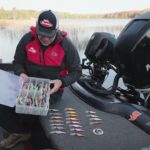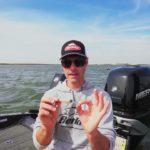Great Lakes Walleye Attractions
Hall of Famers Keith Kavajecz and Gary Parsons are veterans of Great Lakes walleye fishing, and in this article share what they believe to be one of the most important factors to successfully catching walleyes on the Big Ponds.
A pretty lady to a lonely man…a diamond ring to that special woman …a dog to a bone for that matter! How do they all relate to catching walleyes? One word. Attraction. Walleyes need to see your presentation to appreciate how nice it might taste for their next meal. Color can be an attraction. So can sound, as in baits that rattle; but for walleyes that inhabit the vast expanses of the crystal clear waters of Lake Erie, Huron and others, they have become accustomed to responding to flash. Walleyes notice flash. They are sight feeders and they know their meal ticket can be punched by checking out a “flashing” school of smelt or alewives or quite possibly your lure if you’re lucky! There’s a lot of water out there, and getting a walleye to notice your offering over the huge schools of baitfish is no easy task. It takes the right combination of flash, then color and action to draw these fish in.
 The “Flash” Factor:
The “Flash” Factor:
If you’ve ever observed a school of minnows in the water, the first thing that usually catches your eye is their “flash”. That quick glint that is emitted as the minnow moves through the water attracts walleyes too, and when you’ve got a lure that emits flash, that too will attract fish. When it comes to Great Lakes walleye fishing, this “flash factor” has been no secret to success. Looking at some of the most successful Great Lakes lures over the past several years it’s easy to see the pattern develop. The Storm Hot’N Tots with their metal lip were among the first Great Lakes “go-to” baits. The metal lip created the fish attracting flash, while the crank’s body color and action triggered the bites.
When bottom bouncers and spinners began to take off as top walleye catchers across the Midwest, it was the weight-forward spinners that were knockin’ ‘em dead on Lake Erie. The flash of the spinner blade combined with the lure’s color and the addition of live bait were triggering the bites. Then came the evolution of trolling spinner harnesses and crawlers in open water, and the attraction of large spinner blades thumping and flashing through the water drew the fish in.
Great lakes trout and salmon anglers have long used the “flash factor” to attract fish, utilizing such angling accessories as dodgers and flashers ahead of their baits. It didn’t take long before walleye anglers came up with their own style of flashers by adding trolling style flutter spoons inline about 3 feet ahead of spinners to increase the lure’s fish attracting capabilities.
So it’s obvious that to be successful at catching walleyes on the Great Lakes it takes flash to attract the fish, then color and/or bait to trigger the bites. The next step in the evolution would be to combine flash and color to achieve the ultimate in fish attraction.
 Holographic Colors:
Holographic Colors:
A few years ago, Holographic color finishes were added to fishing lures and this was an innovation that anglers had long been waiting for. On spinner blades, the 3’D photo-realistic color patterns are the perfect marriage of color and flash and quickly have became popular among anglers for their effectiveness at catching fish especially in the clear waters of the Great Lakes. But the innovation of Holographics hasn’t stopped at spinner blades … not by a long shot!
The popularity of Holographic colors has spawned a wave of new lure colors and innovations. Berkley for instance, has both Flicker Shads and Flicker Minnows available in “slick” finishes. As the bait swims through the water, this slick finish almost makes the sides of the crank come alive.
We have worked very closely with Bass Pro Shops to develop not only some very dynamic Holographic spinner blades, but spinner bodies and open water trolling weights.
XPS Spinner BladesThe Bass Pro Shops XPS Blade Spacers resemble small baitfish and are designed to replace beads on spinner style crawler harnesses. They come in two sizes (the larger one ideal for Great Lakes size open water spinners), and feature Holographic colors for maximum fish attraction.
 XPS Keel WeightIn-line trolling weights have been used by Great Lakes anglers for years so it only made sense to us that if you could develop a weight that would double as an attractor, it had to work. And it does! The Bass Pro Shops XPS Walleye Keel Weights are shaped like a minnow body, come in a wide range of weights, and again feature an attractive array of Holographic colors.
XPS Keel WeightIn-line trolling weights have been used by Great Lakes anglers for years so it only made sense to us that if you could develop a weight that would double as an attractor, it had to work. And it does! The Bass Pro Shops XPS Walleye Keel Weights are shaped like a minnow body, come in a wide range of weights, and again feature an attractive array of Holographic colors.
Rigging spinners for fishing the big walleyes of the Great Lakes typically takes two forms: One would be to snell up two #2 Beak-style bait hooks like Mustad Ultra Grips or Mustad “Big Red” bait hooks, in tandem about 4 inches apart on 3 to 6 feet of 12# Fluorocarbon like Berkley Vanish, add an XPS Blade Spacer Body, a clevis (wire or changeable) with a size #4 to #6 blade and on the other end of the snell attach a size #12 Berkley Cross-Lok Snap Swivel. Clip the snap to the rear eye of an XPS Walleye Keel Weight(1/2 to 3 ounce depending on desired trolling depth), and attach the front eye of the weight with another snap swivel tied to your main line.
The second style of spinner used for Great Lakes walleyes is to build the spinner on #26 stainless steel wire. In this case, most anglers use a long shank single hook instead of the tandem hook rig. The entire spinner only needs to be about 3 to 4 inches long, and is then connected to the back of the Keel Weight by whatever length of leader is desired. Many tackle shops around the Great Lakes sell the wire forms with the front eye already twisted, so all you need to do is thread on the spinner components, and twist a loop at the back end to hold the hook. When we do this, we also like to put a loop an inch or so up from the hook loop for attaching a stinger hook to if we feel it’s needed. A simple pair of craft pliers is all that’s really needed to work with the wire.
Summary:
Few waters on the planet offer better opportunity for truly phenomenal walleye fishing than the Great Lakes. It’s not always easy fishing however … you constantly find yourself in competition, against both the vastness of the water and big schools of baitfish. Getting your offering noticed is paramount to having success. That means putting baits down there that will attract walleyes like a dog to bone. Put some “flash” in to your presentation next time you hit the water, and you’ll tip the odds in your favor every time.





